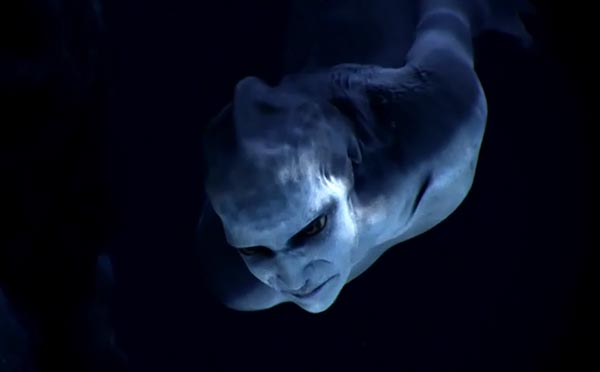 |
  
|
The Aquatic Ape TheoryThere is a popular fringe theory about human evolution that claims we went through an aquatic phase. Skeptoid Podcast #357  by Brian Dunning Today we're going to point the skeptical eye into the world of anthropology, and shine the light of science around to see what we can learn about one of the fringe theories put forth to explain human evolution. It's been promoted on the stage in a 2009 TED talk; it was the underlying theory of Animal Planet's 2011 documentary Mermaids: The Body Found; and it was even described in Desmond Morris' famous 1967 nonfiction book The Naked Ape. It is the aquatic ape theory, an idea first widely publicized by marine biologist Alister Hardy in the 1930s. Its intent is to explain the reason humans are so different from the other great apes. While the other great ape species stayed on land and retained their fur, their knuckle walking, and their lean mass, humans became hairless, upright, and fat as an adaptation to being — for some two million years — an aquatic mammal. The aquatic ape theory was an attempted explanation for why humans differ so much from the other great apes. Hominids all diverged from common ancestors, but Homo sapiens more radically so. We walk upright all the time, we don't have fur, we have bigger brains and are less robust, and so on. A number of people throughout history have noted that there must have been some evolutionary pressure on our line that wasn't on the others. Hardy was among the first to point this out at length, and his notion was that all these major differences are best accounted for if the Homo genus (after our evolutionary split from chimpanzees) went through an aquatic, or at least amphibian, stage. The idea's principal proponent since Hardy has been British screenwriter Elaine Morgan, who has written at least six books promoting the aquatic ape theory as a valid, if not superior, alternative to the standard model of human anthropology which has found that the Homo divergences are the result of adaptations for moving from the trees to the savannah. The technically pedantic among you will note that the aquatic ape idea is not a theory in the strict sense, and thus doesn't deserve the title. In order to graduate from hypothesis to theory, an explanation must be supported by multiple lines of evidence. The aquatic ape idea is at best a hypothesis, and most of its critics refer to it as a hypothesis; but in the popular vernacular it's called the aquatic ape theory. I'm going to call it that today because that's what its creators named it, but do note that nothing has ever been done in anthropology that could conceivably elevate the aquatic ape to the lofty status implied by the word theory. Let's take a look at five of the points raised by aquatic ape proponents, and note how intuitive they do indeed sound. There are a lot more, but these are the most cited five that we have time to cover:
So those all sound pretty compelling, don't they? If the Homo genus was aquatic for about two million years beginning right when we split from chimpanzees and ending about five million years ago when Africa dried up, we've had long enough to adapt to a bipedal dry-land lifestyle ever since. And, the stint created the broad gap between humans and the other great apes we see today. However, as is the case in many branches of science, what appears evident to non-anthropologist laypeople (like marine biologist Hardy and screenwriter Morgan) is not always the whole story. The standard model was not pieced together by throwing darts or by quick glances and first guesses, but by the totality of evidence from many fields of study, including anthropology, paleontology, primatology, human biology, and paleoanthropology. Those whose lives are dedicated to the study of these fields have a much broader picture and already had, and have continued to develop, far more thorough and robust theories. To wit:
The really interesting part of the aquatic ape theory is why it has hung around for so long, and why people would still be taking it seriously today. One primary reason has to do with its simplicity and with the seemingly elegant way that it so thoroughly explains the differences between humans and other great apes. We think of fish as hairless and oily, and humans are hairless and oily too; therefore they're adapted for swimming; it superficially appears to be logical and convincing. Therefore, it's approachable. It's a tidy, bite-sized, comprehensible piece of science ready for consumption by the everyman. Like many fringe theories, the aquatic ape is able to wave eternally popular banners like suppression by the establishment for being unorthodox. In her TED talk, Elaine Morgan said that history is filled with cases of everyone being wrong. Unfortunately, that string of words doesn't support the aquatic ape theory any more than if I invoked it to convince you I could fly. History is filled with cases of everyone being wrong! But only very rarely — I can't think of a single case, actually — is an entire body of scientific research found to be fundamentally wrong by people who lack specialization in that field. If either Morgan or Hardy had been anthropologists, or had ever performed research or written scientific papers about their aquatic ape theory, we might have found out who was wrong. But until someone does, the closest the aquatic ape theory will ever get to being science is as the inspiration for a fake documentary about mermaids. Only then might the theory grow some legs.
Cite this article:
©2025 Skeptoid Media, Inc. All Rights Reserved. |